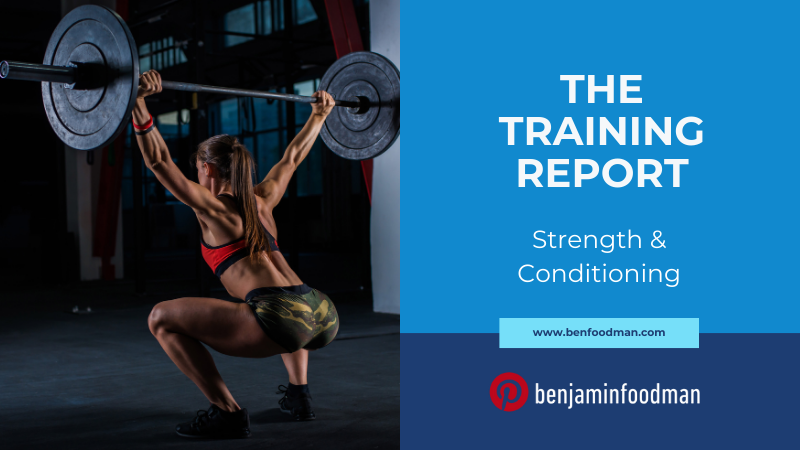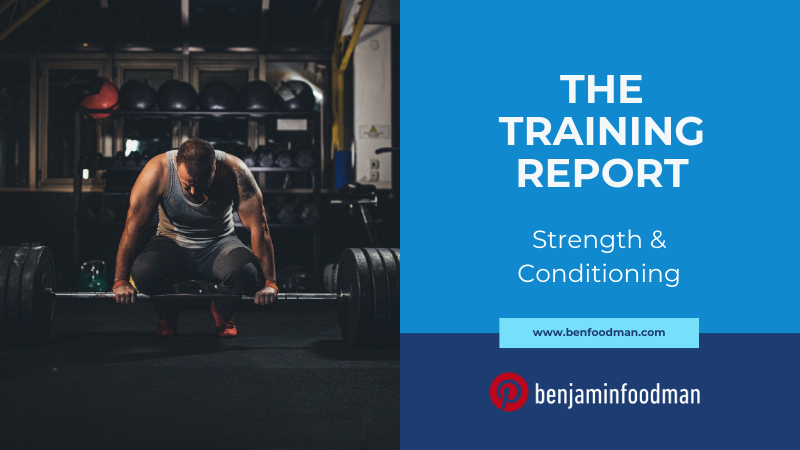Strength & Conditioning - Hypertrophy Programming
About the Author
Ben Foodman is a licensed psychotherapist & performance specialist. He owns his private practice located in Charlotte North Carolina where he specializes in working with athletes to help them overcome mental blocks (the yips), PTSD, ADD / ADHD and achieve flow states through the techniques of Brainspotting & Neurofeedback. If you are interested in services, use the link here! Enjoy the article below!
Introduction: Hypertrophy Training & Athlete Peak Performance
As a Certified Strength & Conditioning Specialist, clients frequently ask me how they can train effectively to add muscle mass. While this may seem like a very simple process, the truth is that the approach will need to be somewhat different per individual. With that being said there are foundational strategies that individuals can use to put themselves in the best position to add muscle through effective hypertrophy programming. Understand that a multitude of factors can potentially affect an individual’s progress: quality of sleep; frequency of exercise; nutrition strategies; lifestyle choices; psychological disposition; body composition, and many important variables.
For this Training Report I want to take the time to review strategies and training protocols that experts utilize when designing hypertrophy exercise regimens. I will first start off by discussing some of the science behind hypertrophy training such as the benefits of adding muscle, how to perform repetitions, and implementation of proper percentages & rep schemes. Next I will provide a sample of a one week hypertrophy program that is based off of standard strength training and hypertrophy tactics. Finally I will cover important nutrition strategies that are frequently implemented in order to add muscle. With that being said let’s start be exploring the science of hypertrophy.
Part I. Program Design & Repetition Standards For Hypertrophy Training
Many athletes and individuals looking to improve in both health and performance usually consult with strength & conditioning specialists in order to effectively add muscle. But what would be the benefit to adding muscle? Per the NSCA ‘a positive relationship exists between hypertrophy and the expression of muscular strength. Biologically, the process of hypertrophy involves an increase in the net accretion of the contractile proteins actin and myosin within the myofibril as well as an increase in the number of myofibrils within a muscle fiber’. Other training adaptations include but are not limited to increases in strength, increases in bone density, increases in cartilage thickness, increase in growth hormone production, and increase motor performance (e.g. running economy, vertical jump, sprint speed, swinging and throwing velocity, kicking performance). So now that we have established the ‘why’ behind increasing muscle mass, what are some important training considerations individuals should factor into hypertrophy programming and training?
In terms of programming, repetitions should range between 8-10 reps. Anything above the standard 10 rep range will fall into muscular endurance training and could actually result in loss of muscle mass. Training programs beneath 8 reps can still result in increases in muscle mass, but true hypertrophy programming seems to yield the best results when individuals stay between 8-10 reps. However, in order to get the most out of this style of training, the load percentage is just as important. Strength & conditioning specialists usually recommend that the program starts within the 60-75% intensity range and eventually work towards 85-90% rep range but with decreased repetitions leading into a d-load week. When working through the main mesocycle, individuals should make sure that each repetition is at a slowed down pace (not excessively slow but not normal speed), and perform the full range of motion (all the way down, all the way up). Now that we have established foundational guidelines for hypertrophy programming, let’s explore a sample one week training program.
Part II. Hypertrophy Programming Sample
DAY 1 - UPPER BODY
Superset 1 - Flat Barbell Bench Press + T-bar Row
3 x 10 @ 6/10 + 3 x 10 @ 6/10
Superset 2 - Standing Barbell Shoulder Press + V-bar Row
3 x 10 @ 6/10 + 3 x 10 @ 6/10
Superset 3 - Incline Dumbbell + Single Arm Dumbbell Row
3 x 10 @ 6/10 + 3 x 10 @ 6/10
Superset 4 - Close Grip Push Up + TRX Single Arm Row Pronated Grip
3 x 10 + 3 x 10
DAY 2 - LOWER BODY
Superset 1 - Front Squat + Hex Bar Deadlift
3 x 8-10 @ 6/10 + 3 x 8-10 @ 6/10
Superset 2 - J-Squat with Gimp Belt (or belt squat machine) + RDL
3 x 8-10 @ 6/10 + 3 x 8-10 @ 6/10
Superset 3 - Kettlebell Sumo Deadlift + Single Leg Kettlebell RDL
3 x 8-10 @ 6/10 + 3 x 8-10 @ 6/10
Superset 4 - Single Leg Step Down + Hemisphere Ball Single Leg RDL
3 x 10 + 3 x 10
DAY 3 - UPPER BODY
Superset 1 - Incline Barbell Bench Press + Bent Over Barbell Rows
3 x 10 @ 7/10 + 3 x 10 @ 7/10
Superset 2 - Cable Chest Fly + Supinated Pull Up
3 x 10 @ 7/10 + 3 x 10 @ 7/10
Superset 3 - Single Arm Dumbbell Chest Press + Single Arm Dumbbell Row
3 x 10 @ 7/10 + 3 x 10 @ 7/10
Superset 4 - Half-kneeling Kettlebell Shoulder Press + Rope Sled Pull
3 x 10 @ 7/10 + 3 x 20-25 pulls per arm
DAY 4 - LOWER BODY
Superset 1 - J-Squat + RDL
3 x 10 @ 7/10 + 3 x 10 @ 7/10
Superset 2 - Barbell Single Leg Back Squat + Hamstring Curl Machine
3 x 10 @ 7/10 + 3 x 10 @ 7/10
Superset 3
Swiss Ball Leg Curl + Kettlebell Front Squat
3 x 10 + 3 x 10 @ 7/10
Superset 4
Single Leg Box Step Down + Single Leg RDL
3 x 10 + 3 x 10
DAY 5 - FULL BODY
Hang Power Cleans From Above The Knees + Power Jerk
3 x 5 @ 7/10
Superset 1 - Barbell Back Squat + Incline Barbell Bench Press
3 x 10 @ 7/10 + 3 x 10 @ 7/10
Superset 2 - Hex Bar Deadlift + Bent Over Barbell Row
3 x 10 @ 7/10 + 3 x 10 @ 7/10
Superset 3 - Diamond Push Ups + Pronated Pullups
3 x 10 + 3 x 10
Part III. Precision Nutrition, Hypertrophy And Strength & Conditioning Outcomes
There are so many variables that go into deciding what foods to consume when trying to increase muscle mass which makes this process incredibly confusing for clients. With that being said, subscribers to the Training Report will be familiar with the fact that I lean heavily on Precision Nutrition for guidance on these issues. When it comes to putting on muscle mass, there are multiple variables that need to be considered from both an individual level as well as what the research suggests when it comes to the aggregate. For instance, individuals looking to increase muscle mass need to honestly assess multiple factors when beginning to calibrate their nutrition performance.
Some of these factors include the following: what is the amount of physical activity that you can honestly commit to; is changing your regular diet something that is realistic; what was your expertise level of nutrition strategies before you began this; are there extenuating life circumstances that might prevent you from being consistent; how committed are you to sleep performance. However someone answers these checklists will most likely dictate which approach may be best for you. Understand that these are not nutrition prescriptions, and individuals should consult with licensed professionals within the field of nutrition. Nonetheless, I am going to provide different strategies that Precision Nutrition recommends employing when individuals are making changes to be able to increase muscle mass. Let’s review Level 1 Precision Nutrition strategies.
Precision Nutrition Strategies For Hypertrophy Training
Precision Nutrition Level 1 strategies are guidelines that apply to the vast majority of people. There are Precision Nutrition Level 2 & 3 strategies, but those are reserved for individuals who are trying to prepare for a body building competition, a modeling photoshoot, or individuals training for a time sensitive sport event (Level 2 & 3 strategies can have adverse health effects if not properly supervised by a professional). Level 1 strategies are not only perfectly applicable for the majority of casual exercisers, but also professional and collegiate athletes (think of the Level 1, 2, & 3 strategies as categories, not rankings). So with that being said, there are several important features that go into Level 1 strategies as it relates to increasing muscle mass:
Hand Portion Measurements
When most people start changing their calorie intake, people use different apps and obsess over calorie counting. There are many reasons why this is not a sustainable approach. Instead, start using your hand to measure portion sizes: A serving size of protein = 1 palm; a serving of vegetables = 1 fist; a serving of carbs = 1 cupped hand; and a serving of fats = 1 thumb. Your fueling goals will dictate the different portion requirements.
PN Meal Profiles
Precision nutrition offers a starter template to give individuals a general sense of how the hand portion sizes work. For instance, most moderately active women will utilize the following daily portion methodology: 4-6 palms of protein dense food; 4-6 fists of non-starchy vegetables; 4-6 cupped handfuls of carb-dense foods; and 4-6 thumbs of fat-dense foods. This translates to about 1400 to 2100 kcals (moderately active men translates to 6-8 palms of proteins, 6-8 fists of non-starchy vegetables, 6-8 cupped handfuls of carbs & 6-8 thumbs of fat dense foods). Depending on energy needs & goals, individuals need to adjust portions accordingly.
PN Strategies
The following Precision Nutrition strategies will help individuals get the most out of their nutrition performance: choose higher quality foods more often such as adding more whole, minimally processed foods (research shows this improves nutrient intake, meal satisfaction, digestion, natural self-regulation of energy balance and overall health); incorporate regimented rest & recovery during training; create a supportive environment (e.g. removing foods not in line with your goals from your pantry…if a food is in your house, you will eventually eat it); regulate emotions without food and eating (e.g. slow down speed of eating and mindfully eat, pay attention to sensations during eating).
PN Level 2 Tactics
Level 2 tactics does not mean ‘more advanced’. PN level 2 tactics are a category. As previously mentioned, elite athletes can be just as successful only using level 1 strategies and are encouraged to stay in Level 1. But for individuals looking for temporary (all level 2 tactics should be time limited and have an end date) recommendations, Precision Nutrition recommends for athletes involved in bodybuilding, explosive power, conditioning & relative strength exercises to utilize these average starting percentages for this macronutrient profile: 30% protein; 40% carbohydrates; & 30% fats.
Adjust For Body Composition
Not losing fat within realistic parameters - decrease intake by about 250 calories a day by cutting out some carbs and/or fats, or simply remove 1 cupped handful of carbs and/or 1 thumb of fats from a few of your daily meals
Not gaining muscle within realist parameters - increase intake by about 250 calories a day by adding some carbs and/or fats or simply add 1 cupped handful of carbs and/or 1 thumb of fats to a few of your daily meals
Losing too much lean mass when losing weight - increase daily protein intake by about 25 grams or simply add 1 extra palm of protein to one meal each day
Gaining too much fat when adding muscle - increase daily protein intake by about 25 grams and decrease daily carb and/or fat intake by about 250 calories or simply add 1 extra palm of protein to one meal each day, and remove 1 cupped handful of carbs and/or 1 thumb of fats from a few of your daily meals
Note To Reader:
If you are an athlete reading this segment of the TRAINING REPORT, hopefully this content was helpful! I put the Training Report together because I felt like many of the discussions on issues such as the Yips/mental blocks, strength training & other subject matter on athlete performance concepts were really missing the mark on these ideas (e.g. how trauma is the direct cause of the Yips). If you are interested in learning more, make sure to subscribe below for when I put out new content on issues related to sport psychology & athlete performance! Also, if you are looking to work with a mental performance specialist, you are in the right place! USE THIS LINK to reach out to me to see if my services are the right fit for your goals!
ARE YOU ON THE LIST?
Make sure you’re signed up to Ben’s mailing list to receive news & updates on new strategies in sport psychology, upcoming workshops & products. Don’t wait, sign up now!































